



Paramus History Marker
N. Farview Ave. - in front of Petruska Park
Map / Directions to the Paramus Marker
Map / Directions to all Paramus Revolutionary War Sites
This sign in front of Petruska Park gives a brief history of Paramus, including its Revolutionary War significance. Paramus has several interesting Revolutionary War historic sites, which are detailed in the following entries. [1]



Red Mill Site Marker
Red Mill Rd.
Marker is just inside of the small park that contains Easton Tower
Map / Directions to the Red Mill Site
Map / Directions to all Paramus Revolutionary War Sites
This sign marks the area where the "Red Mill" once stood. The mill was built in 1745, and was owned by Jacob Zabriskie at the time of the Revolutionary War. It acquired the "Red Mill" name in the early 1800's when its later owner Albert Westervelt painted it red. [2]
The Red Mill sign describes some events of Revolutionary War significance which occurred in and around Paramus. It states that the area was the "scene of many raids and encounters during the Revolution. Aaron Burr was entertained here Christmas Eve commemorating his victory over British Raiders in 1776. Washington and his men often passed here. Lafayette stopped here on his return visit to America in 1825." [3] General Lafayette was a French General who fought for the American side in the Revolutionary War. He developed close friendships with Washington, Hamilton, and other Revolutionary War figures. Decades after the end of the war, Lafayette made a return visit from France to the United States from August 16, 1824 - September 7, 1825. At that time, the United States consisted of only 24 states, and Lafayette visited all of them. Other historic sites associated with Lafayette's 1824/1825 visit to America can be found in Elizabeth, Hackensack, Morristown, Newark and Woodbridge. [4]
The historic marker is just inside a small park that also contains Easton Tower (shown below). Follow the path next to the sign into the park and you will come to the tower, which was originally used to pump water to irrigate the estate of Edward Easton. Easton was a founder of the Columbia Phonograph Company, which later became Columbia Records. The stone and wood frame tower was built in 1900 as part of a landscaped park which was commissioned by Easton. [5] While the tower is from a later era and has no Revolutionary War significance, it is a very interesting and attractive site that is well worth visiting.

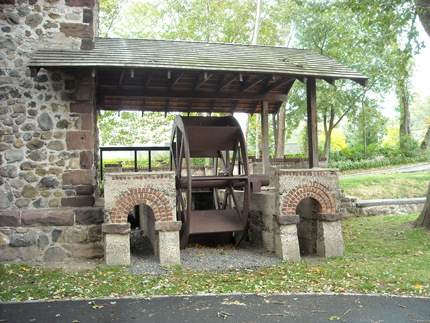

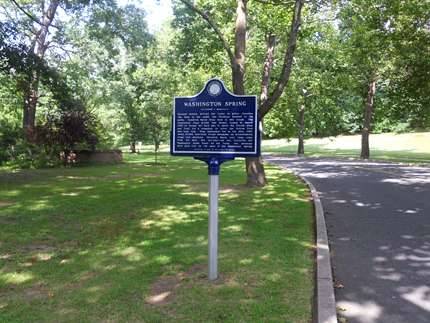

Washington Spring
Van Saun County Park / Continental Ave.
Located in Section D of the Park
Map / Directions to the Washington Spring Site
Map / Directions to all Paramus Revolutionary War Sites
The Washington Spring site takes its name from reports that General Washington drank water from the spring here while his troops were encamped nearby, west of the Hackensack River. A large blue sign in Section D of the park explains, "Howland Avenue divided the farms of miller Cornelius Van Saun to the south and Christian Dederer to the north. Hendrick Banta lived west of Mill Creek. The Continental Army moved into Bergen County in August 1780 to forage for food and to await the French army and fleet for a campaign to drive the British from New York City. From September 4th to the 20th, 1780, about 14,000 American troops encamped on Kinderkamack ridge and environs. Hendrick Banta sold them cider from his mill. His ten-year-old son Cornelius saw Washington three times on his horse. His presence here gave rise to the name of Washington Spring." [6]
Walking past this sign, you will go down a path through a pillared opening (pictured below left). At the end of the path is another sign which reads, "The Continental Army is reported to have utilized the old spring at the base of these slopes during the September encampment west of the Hackensack River. Reports indicate that General Washington visited here and drank from the spring." [7] Past this sign is a very attractive gardened section of the park which contains short pathways around the Washington Spring.
Other locations in Bergen County associated with the August-September 1780 encampmnent can be found in Englewood, Oradell, Paramus, River Edge and Teaneck

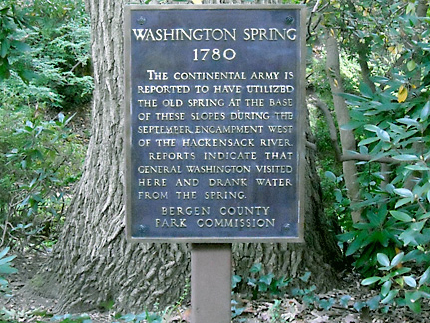

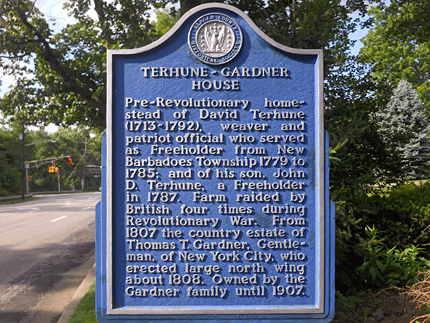

Terhune-Gardner House
218 Paramus Rd.
Map / Directions to the Terhune Gardner House
Map / Directions to all Paramus Revolutionary War Sites
This house is a private residence.
Please respect the privacy and property of the owners.
This was the homestead of David Terhune, a weaver who served politically during the Revolutionary War era. He was a freeholder from 1779 - 1785 representing New Barbadoes Township. New Barbadoes was a township located in this area of Bergen County that dated back to 1693. Portions of it were used in the formation of other townships throughout the 1700's and 1800's. What remained of New Barbadoes in 1921 became Hackensack city.
During the Revolutionary War, British troops raided the Terhune's farm on four separate occasions. [8] The house is partly visible from the Paramus Road, through gaps in the hedges.

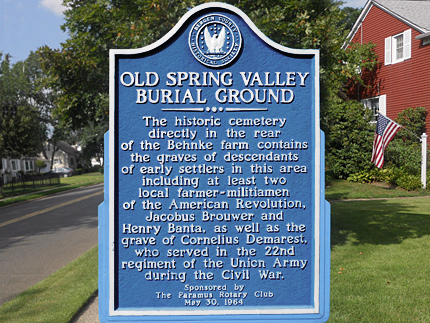
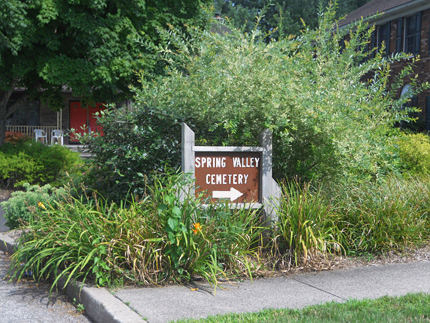

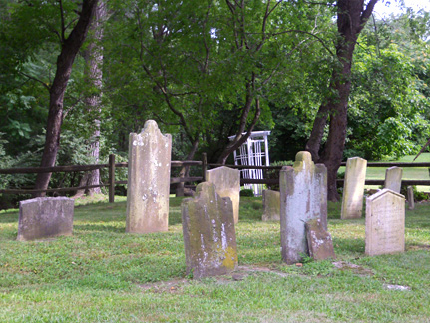
Old Spring Valley Burial Ground (Spring Valley Cemetery)
Cemetery Entrance is on Viola Way
Blue Historic Marker is around the corner on Spring Valley Rd.
Map / Directions to the Old Spring Valley Burial Ground
Map / Directions to all Paramus Revolutionary War Sites
This cemetery, and the pathway to enter it,
are surrounded by neighboring houses.
When visiting this cemetery, please respect the
privacy and property of the neighbors.
This cemetery, which dates back to the late 1700's, is tucked away in the middle of a residential area. It contains the graves of at least two local farmers who served in the militia during the Revolutionary War: Henry Banta (July 1, 1751 - August 19, 1817) and Jacobus Brouwer (Died August 26, 1784). [9]

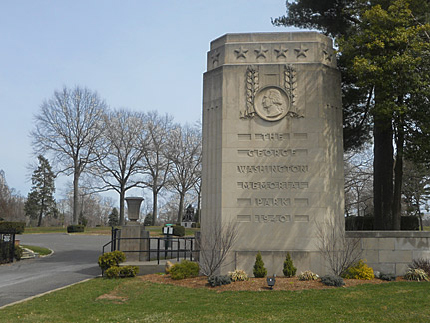


George Washington Statue
Inside the George Washington Memorial Park Cemetery
Paramus Rd. and Century Rd.
Map / Directions to this George Washington Statue
Map / Directions to all Paramus Revolutionary War Sites
Inside the cemetery is a very impressive statue of George Washington. The statue, titled George Washington Kneeling in Prayer, stands nine-and-a-half feet tall on a three-foot granite base and weighs more than 3 tons. It was designed and sculpted by Donald DeLue (1897 – 1988), an internationally known sculptor who lived and worked in Leonardo, NJ. His works included The Spirit of American Youth monument at the Normandy American Cemetery, where many who died on D-Day are buried. DeLue was unable to complete this statue due to his failing health. He arranged for his friend Granville W. Carver to complete it, which he did after DeLue died in 1988 at age 91. DeLue also designed a different version of the George Washington Kneeling in Prayer statue which stands at Valley Forge. [10]

1. ^ This is a Bergen County Historical Society sign
▸ Paramus, which had been a part of Midland Park, was made a borough in a referendum on April 4, 1922, according to:
John F. Snyder, The Story of New Jersey's Civil Boundaries: 1606-1968 (Trenton: Bureau of Geology and Topography, 1969) page 84 Available as a PDF on the State of New Jersey website here.
2. ^ Easton Tower page of the Bergen County Parks website
3. ^ Quoted text from the Red Mill - Paramus historic sign, which was erected by Red Mill Chapter of the Daughters of the American Revolution
4. ^ For more information about the sites in Elizabeth, Hackensack, Morristown, Newark and Woodbridge, along with accompanying source notes, see those individual town pages on this website.
5. ^ Easton Tower page of the Bergen County Parks website
6. ^ Bergen County Historical Society sign, dedicated in 2005 by the County of Bergen
7. ^ Bergen County Park Commission sign
8. ^ Information about David Terhune and the homestead was drawn from the Bergen County Historical Society sign in front of the house.
• For a detailed timeline of New Barbadoes and its land being used to form other townships and cities, see:
John F. Snyder, The Story of New Jersey's Civil Boundaries: 1606-1968 (Trenton: Bureau of Geology and Topography, 1969) page 82 Available as a PDF on the State of New Jersey website here.9. ^ Information drawn from the Bergen County Historical Society sign on Spring Valley Road, and gravestones in the cemetery.
10. ^ Information about the George Washington Kneeling in Prayer statue and its sculptor Donald DeLue was drawn from:
Joseph Lanciotti, George Washington Memorial Park Cemetery: They Built for the Ages (Bloomington: Author House, 2007) pages 83-84• For information about DeLue's The Spirit of American Youth sculpture in Normandy, see:
Normandy American Cemetery and Memorial (American Battle Monuments Commission, 1957) Pages 2 - 5
Available to be read at the Internet Archive here